6 STRETCHES TO RELIEVE CONSTIPATION - TRAINING, AND BENEFITS
- Medically reviewed by: Horia Marculescu, MD
- Photo credits: Licenses / Author
- Last updated: Jul 18, 2024

Here are six stretches to relieve constipation to practice in the comfort of your home:
- Up and down shoulder stretch;
- Clockwise hip stretch;
- Hip-opening deep squat stretch;
- Supine twist;
- Crescent Twist;
- Cobra stretch.
Shoulder stretches can facilitate abdominal contractions, increasing pressure inside the intestines. Hip stretches induce muscle contractions in the lower abdomen, promoting the movement of stool towards the rectum.
Deep squat hip stretches can increase the anorectal angle, facilitating a clear path for stool evacuation. Consistent practice of these stretches can promote natural bowel movements and stool evacuation in the long term.
Yoga stretches are particularly suitable for flexible individuals, as they demand minimal effort and attention.
1. UP AND DOWN SHOULDER STRETCH
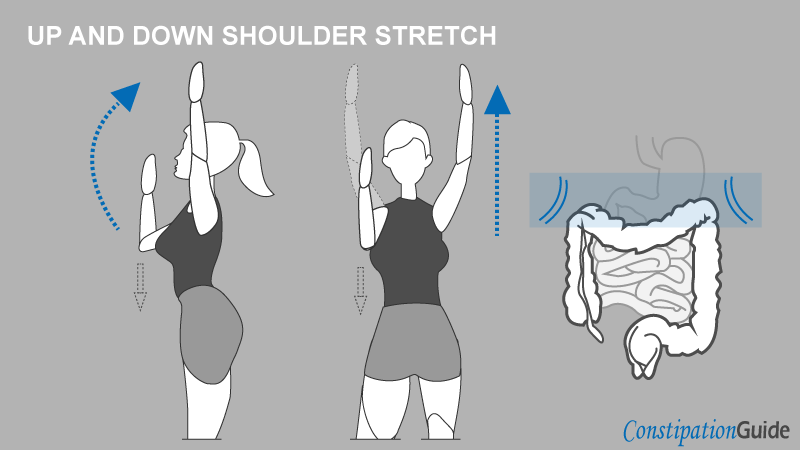
These stretches to relieve constipation engage the shoulders and hands to contract the upper abdomen. They also help in pushing stool towards the rectum.
Doctors recommend these stretches not only for shoulder recovery and preventing injuries but also for individuals who spend extended periods at a desk or computer, as they help in abdominal stimulation.
These stretches aim to contract and expand the intestines through the engagement of the upper abdomen.
How to Perform Up and Down Shoulder Stretches:
- Stand with your feet shoulder-width apart, maintaining an upright posture.
- Extend your arms straight out in front of you, with your palms facing towards your mouth.
- Keep your hands raised in the air at shoulder level.
- Lift your right hand upwards towards the ceiling.
- Slowly lower your right hand back down to its initial position.
- Repeat the same movement with your left arm.
Practice this exercise slowly and gently. Begin with ten repetitions for each hand. Aim to repeat the exercise 3-4 times.
Avoid sitting on a chair or couch while performing these stretches, as sitting can compress the intestines. Ideally, you want to engage in stretches that allow for the free movement and expansion of the intestines.
Slow practice yields better results, as it allows for gentle muscle movements. Rushing through exercises, especially during warm-up, is counterproductive.
Benefits of Shoulder Stretches:
Shoulder stretches are simple to practice and create pressure within the intestines, facilitating movement from the abdomen toward the rectum.
These stretches aid in preventing shoulder soreness and wrist injuries. They help to enhance wrist strength, which is particularly beneficial for individuals who spend prolonged periods driving or working at a computer.
Everyone can practice shoulder stretches using various hand directions. Incorporating lateral movements of the shoulder further strengthens the shoulder muscles and enhances abdominal contraction.
In a medical article titled "Innovation & Technology in Gastroenterology" by The American College of Gastroenterology, it's recommended that patients incorporate arm vibrations into their routine to enhance constipation relief and achieve a higher rate of complete bowel movements.
According to the "Physical Activity Goals" guide from the same health authority, engaging in light stretching of the neck, arms, shoulders, back, hips, and legs helps prevent injuries when increasing activity levels.
As outlined in the "Four Types of Exercise Can Improve Your Health" guide by The U.S. National Institute of Aging, stretching enhances flexibility, particularly in areas like the back, inner thigh, ankle, and back of the leg. It's crucial to incorporate stretching into warm-up routines or after endurance exercises.
2. CLOCKWISE HIP STRETCH
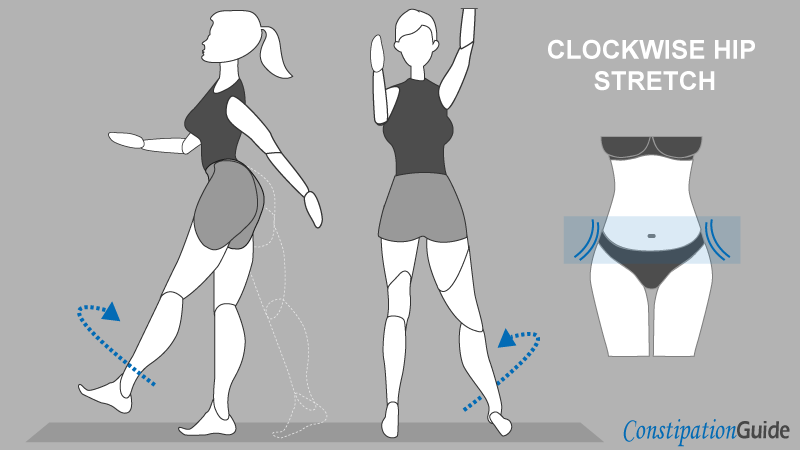
These stretches to relieve constipation are suitable for all as they are easy to perform and require minimal effort.
The aim of clockwise hip stretches is to enhance bowel movement by engaging the lower abdomen and pelvic floor muscles.
Both clockwise and counterclockwise movements yield similar effects. To optimize results, begin slowly and gently, as excessive pressure may cause discomfort or stiffness.
How to Perform Clockwise Hip Stretches:
Position yourself near a door frame or stair support to ensure stability and do the following:
- Stand straight.
- Extend your right leg sideways.
- Keep the ankle straight and the leg extended.
- Rotate your leg in slow circles.
Maintain straight alignment of the body and feet. Extend the leg as far as possible. Repeat this exercise for each leg ten times in both clockwise and counterclockwise directions, performing the movements slowly.
For fast relief from constipation through exercise, incorporate sit-ups or deep squats. Avoid rushing through these stretches, as results may not be immediate. Take your time and pause when necessary.
Benefits of Round Hip Stretches:
Engaging and releasing the pelvic floor muscles is crucial for facilitating smooth defecation. Additionally, consistent movement improves the rectum's responsiveness to stool evacuation.
Circling the hips and legs facilitates effective hip recovery and injury prevention.
Doctors advocate for this exercise, particularly for individuals with prolonged sitting or driving habits. Performing circular leg movements enhances wrist strength and helps alleviate soreness.
In a study on static stretching and hip flexion in athletes published by The U.S. National Institutes of Health, researchers found that the timing of rest intervals between stretches significantly impacts stretching effectiveness.
This practice allows for the recovery of the nervous, muscular, and metabolic systems, enhancing the muscles' capacity to extend against resistance.
According to the Diabetes Diet, Eating & Physical Activity guide published by The National Institute of Diabetes and Digestive and Kidney Diseases, stretching can be regarded as moderate physical activity. Stretching routines promote flexibility, reduce stress levels, and mitigate muscle soreness.
In a study on physical activity, defecation, and constipation published by The U.S. National Library of Medicine, doctors recommend physical activity to middle-aged and inactive patients suffering from constipation.
Engaging in physical activity improves defecation patterns and reduces rectosigmoid colonic transit time.
3. HIP-OPENING DEEP SQUAT STRETCH
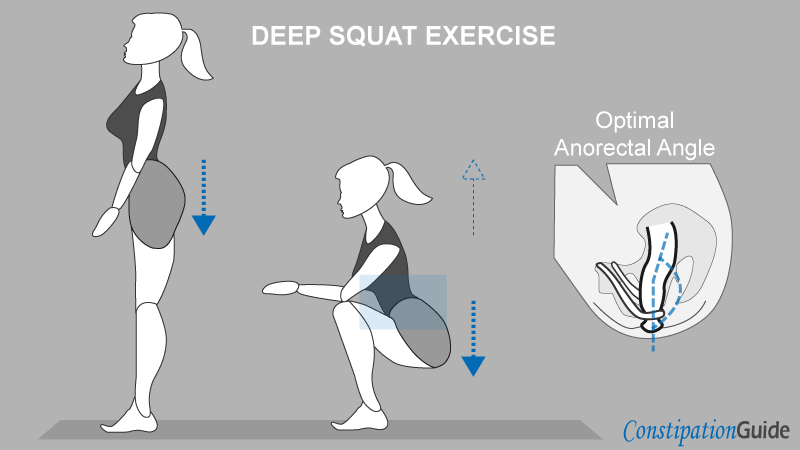
Hip-opening deep squat stretches stand out as optimal stretches for constipation relief. Their ability is to elevate the anorectal angle, paving a clear pathway for stool evacuation.
These stretches play an essential role in stimulating bowel movement. They ensure smooth stool evacuation in both the short and long term.
Squatting and semi-squatting postures are highly beneficial for bathroom use, fostering a natural stool evacuation experience without the tension that may lead to adverse effects such as hemorrhoids.
How to Perform the Hip-Opening Deep Squat Stretch:
- Begin by standing straight on your feet, ensuring there is some space between your heels and knees to maintain stability.
- Lower your body slowly while keeping your back straight.
- Maintain the position with your knees higher than your hips.
- Place your elbows on your knees and position your arms between your legs.
- Stay in this position and gently move your elbows laterally to extend the hips. Keep your elbows and hips steady while performing this movement.
- Hold this stretch for 10-30 seconds, then take a brief pause.
- Repeat the exercise for 1-5 sets, performing each repetition slowly and gently. The objective is to create space between your legs while keeping your knees higher than your hips.
By doing so, you increase the anorectal angle and open the kink at the entrance of the rectum, facilitating a clear pathway for stool movement downwards.
Benefits of the Hip-Opening Deep Squat Stretch:
- Increases the anorectal angle, facilitating smoother defecation.
- Enhances the natural feel of the defecation process.
- Engages the pelvic floor muscles effectively.
Regular practice of this posture enables the body to generate sufficient intestinal pressure. Pressure leads to easier stool evacuation.
Hip stretches prevent wrist injuries and pelvic floor muscle soreness. Medical professionals endorse this type of stretch for hip recovery.
According to a guide on constipation and defecation issues published by The American College of Gastroenterology, biofeedback therapy, physical activity, and muscle retraining exercises are effective in treating pelvic floor coordination problems. These techniques apply to issues with anorectal muscles.
Health experts from The U.S. National Center for Complementary and Integrative Health advise performing stretching correctly and gently. They recommend incorporating stretching into your daily routine.
4. SUPINE TWIST
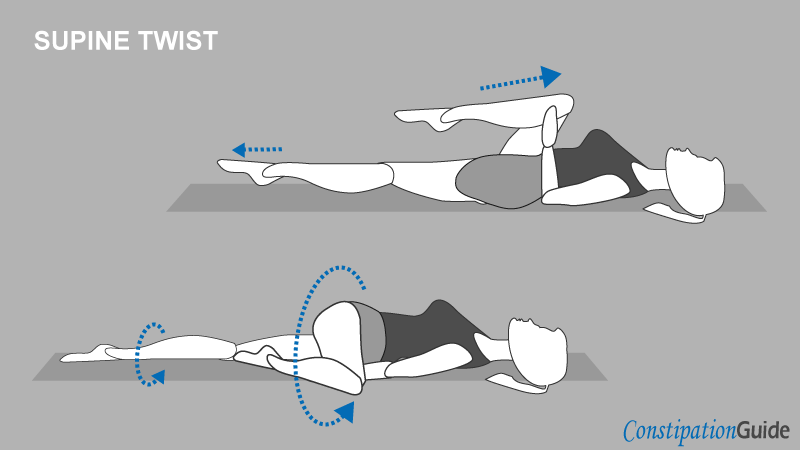
The supine twist stretch is a yoga pose known for its benefits in stimulating bowel movements, relieving stress, promoting joint mobility, enhancing blood circulation, and facilitating the movement of stool within the intestines.
This yoga pose offers the advantage of stretching the hips similarly to squatting, making it one of the best stretches for constipation relief.
How to Perform the Supine Twist for Constipation Relief:
Lie on your back with your body straight, head and shoulders aligned, and gaze directed upwards.
Follow these steps:
- Slowly bring your knees towards your chest.
- Extend your right leg straight back.
- Guide your left leg to the right side.
- Maintain alignment of your head and body.
Hold this position for 1-5 seconds, then repeat with the other leg.
The feeling of a gentle stretch in the hips and thighs indicates proper execution. Avoid overstretching, especially if flexibility is limited.
Benefits of the Supine Twist Stretch
This stretch is simple to practice and requires minimal effort, only necessitating a fitness or yoga mat. It serves as an effective exercise for hip recovery and injury prevention.
The wind-relieving pose closely resembles this stretch, as both involve bringing the legs close to the chest, allowing for simultaneous practice of both poses.
Keeping the knees close to the chest increases the obtuseness of the anorectal angle, facilitating smoother stool evacuation with reduced rectal straining.
Health experts from the U.S. National Institutes of Health (a study on constipation, IBS, and Yoga) recommend a remedial yoga module for IBS in a supine position involving both legs (straight leg raise breathing).
The same health authority suggests that exercises such as breathing techniques, abdominal stretching, and twisting postures (with rest included) have more promising results.
5. CRESCENT TWIST
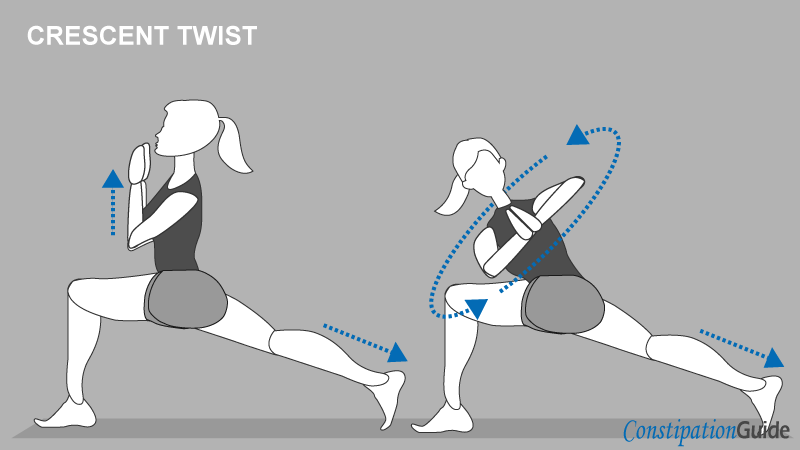
These yoga stretches relieve constipation by generating pressure within the intestines and engaging the abdomen and pelvic floor muscles.
The crescent twist pose requires significant effort, particularly on the knees and heels, making it more suitable for individuals in good physical condition with flexibility.
How to Perform the Crescent Twist for Constipation Relief:
Begin by sitting on the floor with your legs extended straight ahead. Slowly bring your right foot forward, extending your left leg and hip backward as far as possible. Ensure that your right knee and ankle are perpendicular to the floor.
Follow these steps:
- Extend your hands in front of your chest.
- Rotate your entire body to the left.
- Place your right elbow on your right knee.
- Maintain this position for 1-5 seconds.
Gently and gradually stretch the hips and lower abdomen. Repeat the stretch on the left side of your body with the other leg.
The Crescent Twist offers additional benefits to the body.
It enhances blood circulation and promotes stool movement towards the large intestine and rectum.
Moreover, it serves as a valuable exercise for individuals aiming to prevent muscle soreness and wrist injuries.
Due to its demanding nature, this exercise engages multiple muscle groups simultaneously, including the abdomen, shoulders, legs, and hips, making it an effective and practical workout for improving stamina.
According to a study on high-intensity yoga and fitness published by The Journal of Alternative and Complementary Medicine, incorporating high-intensity yoga postures, along with 30-40 minutes of classical Surya Namaskar and 15 minutes of other poses, yields favorable results.
Similarly, a study on spastic cerebral palsy and stretching exercises published by NCBI indicates that stretching exercises can effectively alleviate symptoms, contributing to the management of spasticity in CP.
6. COBRA STRETCH

Unlike other constipation-relief stretches, the Cobra Stretch requires no twisting. It's a low-effort stretch yet highly effective for abdominal workouts and relieving constipation.
Known as a staple yoga pose globally, the Cobra Pose mimics the defensive stance of a cobra, providing a deep stretch to the lower abdomen and thighs, aiding in relieving constipation.
How to Practice the Cobra Stretch for Improved Bowel Movement:
Begin by positioning yourself on a fitness mat, facing downwards with legs and knees firmly pressed against the mat:
- Lie flat on your abdomen with your legs extended.
- Place your palms firmly on the mat beneath your shoulders.
- Gradually lift your head towards the ceiling.
- Slowly elevate your chest while maintaining a controlled movement.
- Press your palms firmly into the floor to support your upper body.
- Ensure your upper body remains vertical.
Hold this pose for 1-5 seconds, or extend it to 10-30 seconds for those with greater flexibility. Conclude by gently lowering your body back to the mat.
Maintain a straight alignment throughout, perpendicular to the floor. This posture facilitates contraction of the abdominal muscles and expansion of the intestines, aiding in bowel movement.
“Yoga postures targeting the lower abdomen would help in relieving the symptoms of IBS by enhancing bioenergy circulation in and around the intestines.”
ADDITIONAL CONSTIPATION-RELIEF STRETCHES
In addition to the Cobra Stretch, three yoga-related stretches can help alleviate constipation:
- Bow Pose: This pose involves bending your knees behind you while lying on your abdomen, effectively stretching the abdominal muscles.
- Matsyasana (Fish Pose): By arching your back and lifting your chest, Matsyasana provides a deep stretch to the body, particularly beneficial for the abdominal region.
- Half Spinal Twist: This pose involves similar movements to the supine twist stretch, emphasizing deep breathing to enhance the stretch in the hips and lower abdomen.
Yoga stretches are more flexible-oriented, while shoulder and hip stretches are universally suitable.
According to The National Institute of Diabetes and Digestive and Kidney Diseases, regular physical activity relieves constipation without requiring athleticism.
“Modest amounts of physical activity are beneficial to your health and digestion. This thing doesn’t mean that you have to be an athlete. ”
SUMMARY
In summary, incorporating stretches to relieve constipation is essential for long-term improvement in stool evacuation and bowel movement.
The initial three stretches outlined in this guide—shoulder stretch, clockwise hip stretch, and deep squat stretch—are generally suitable for most individuals.
Some yoga stretches, like the supine twist, crescent twist, bow stretch, and wind-relieving pose, provide effective relief despite requiring minimal effort
Last medically reviewed on Jul 18, 2024
